Review: Samsung Galaxy S9+
Mar 8, 2018, 8:00 AM by Eric M. Zeman
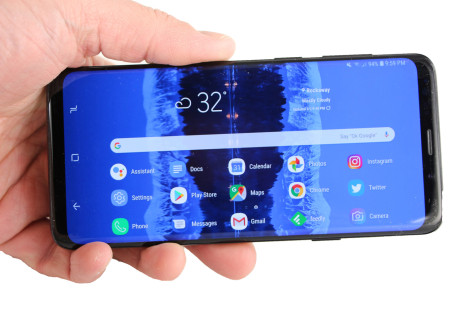

Samsung's flagship handset is here and it's a curvaceous, complex piece of consumer electronics. The Galaxy S9+ seemingly has it all: the good looks, the high IQ, and the killer skill set that sets it atop the Android pedestal. Can anything waylay the latest from Samsung? Find out in Phone Scoop's in-depth review of the Galaxy S9+.
Is It Your Type?
Some people simply have to own the latest and greatest thing, no matter how great that thing actually may be. The Samsung Galaxy S9+ is an update to last year's S8+ and makes just the right number of improvements, with a keen focus on photography, to call it a wholly better phone. The S9+ is for those who want the best of the best no matter the cost.
Body
Samsung has fully adopted Apple's tick-tock rhythm for updating its flagship Galaxy S series handsets. The S6 and S7 were nearly identical from a design perspective, and so are the S8 and S9. As I said in my hands-on, where last year's S8+ was a generational leap forward, this year's S9+ takes a good idea and increments it to be even better.
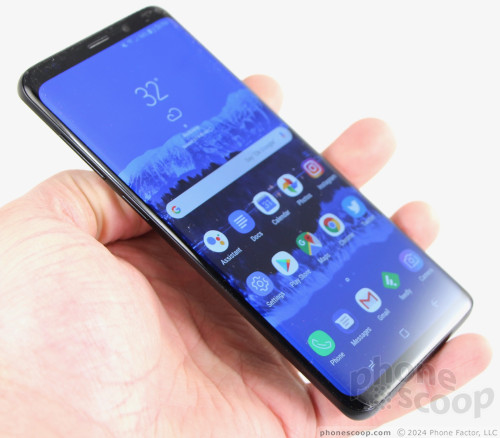
Only the most observant will be able to spot the differences between the S8+ and the S9+ hardware, especially from the front. The S9+ has a thin metal frame sandwiched between two curved pieces of glass. Samsung gave the metal a new matte finish that I really like. The frame wraps all the way around the outer edge and is only a couple of millimeters thick along the sides; it swells up at the top and bottom. The frame is colored to match the black, blue, and lavender colors offered this year.
The uniformity of the shape, the thin profile, and the luscious materials all contribute in making the S9+ a gorgeous piece of hardware, even if it hasn't changed much from its predecessor.
There's no question the S9+ is a big phone. It stands 6.22 inches tall and 2.91 inches wide. Thanks to the 18:9 display and razor-thin side bezels, it's more than twice as tall as it is wide. Each piece of Gorilla Glass is 20% thicker on the S9+ when compared to the S8+, which Samsung claims gives them added strength. The thicker glass makes for a slightly thicker and heavier phone than the S8+. The S9+ definitely feels weighty.
It can be difficult to reach the top of the screen with your thumb; you might find yourself juggling the S9+ in your grasp a bit. If you have medium-sized or large hands, using the S9+ shouldn't be problematic, but if you have small hands you might want to consider the more compact S9 instead. I found the phone fit into pockets pretty well.
Hand Fit
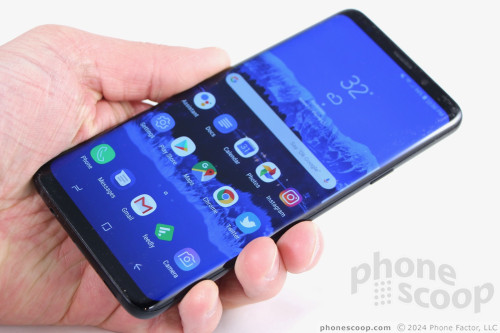
I should point out that the S9+ is slightly smaller and rounder than the Note8. While the difference is small on paper, it makes a surprisingly huge difference in person. The Note8 is taller and has sharper corners, making it relatively unwieldy. If the Note8 was too much phone for you, the S9+ may be a better option.
The S9+ is one of the finest phones I've handled. Samsung picked high-quality glass and aluminum and mated the differing materials perfectly. The seams between metal and glass are nonexistent. Samsung has fully mastered its ability to curve glass and create sleek, sumptuous smartphones.
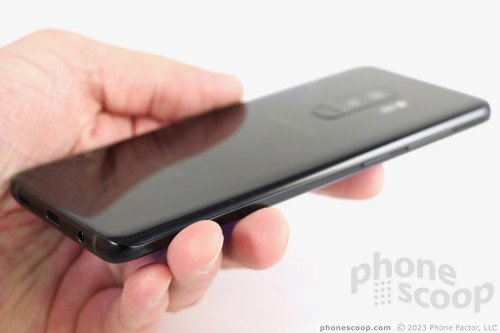
The whole point of Samsung's Infinity Display is to give the phone the appearance of being "all screen". Samsung accomplishes this better than most. Samsung has essentially eliminated the side bezels thanks to the curved screen. Bezels above and below the display are as thin as it gets (at least without resorting to a "notch"). The earpiece grille, iris reader, and user-facing camera are all but invisible on our black review unit, but more easily spotted on the colored variants. With no interruptions to the glass, the front face is entirely smooth.
Samsung made slight improvements to the buttons and controls located around the outer edge of the phone. The layout is the same as on the S8+, but all the keys now have thicker profiles and are easier to find and use. A dedicated hardware key on the left edge launches Samsung's personal assistant, Bixby. The volume toggle is above the Bixby key. It's only about an inch long. The lock button is on the S9+'s right edge. All of these buttons have excellent profiles, and perfect travel and feedback.
Samsung tucked the nano SIM and microSD memory card tray in the phone's top edge. A SIM tool pops the tray out easily. The USB-C port is on the bottom, as is the 3.5mm headphone jack.
Bottom Edge
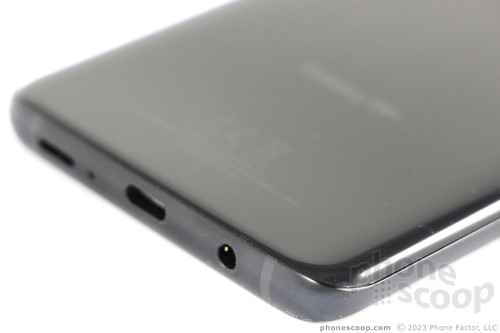
The S9+ is rated IP68 for protection against water, dust, etc. Technically, it can sit in 1.5 meters (~4.5 feet) of water for up to 30 minutes with no worries. Waterproofing is a table-stakes feature at this level. I tested the phone in a bathtub and found it no worse the wear for its bath.
As noted, both the front and rear glass panels are made from thicker Gorilla Glass 5, but we discovered that doesn't mean much. It may be tougher, but it's still glass. We dropped our naked review unit just once, from about waist height, and the rear glass shattered. Put a case on this phone, please.
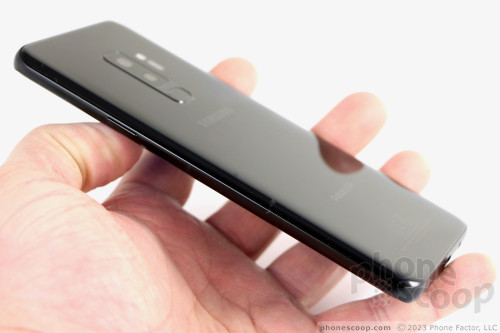
The S9+'s rear panel is nearly all uninterrupted glass. Like most glass handsets, you'll find yourself wiping oily grime off the back constantly. Fingerprints are most noticeable on the black model, and much less so on the blue and lavender.
Thank goodness Samsung took all the complaints about the fingerprint reader on the S8+ to heart and corrected its mistake. The fingerprint reader is now exactly where you expect to find it: right in the middle, below the camera. This is a huge improvement. On a day-to-day basis, the fingerprint reader of the S9+ is far easier to find and use than that of the S8+. A heart rate monitor also adorns the rear panel.
Fingerprint Reader
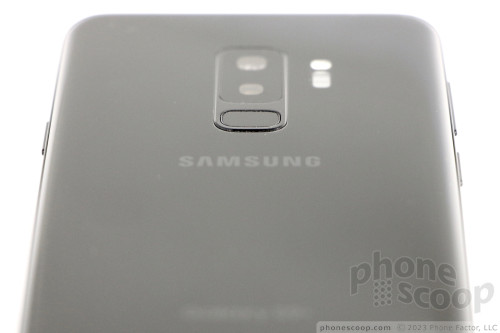
The rear cannot be removed; the battery is inaccessible.
The Galaxy S9+ is not a radical departure from its predecessor, but it takes the right steps forward. The rearranged fingerprint reader is the single biggest improvement, making the phone a more usable device. It's just as attractive and just as desirable, if not more so.
Screen
Samsung did not change the screen at all from last year's phone. The S9+'s display measures 6.2 inches and it maintains the 18.5:9 aspect ratio. A year ago, 18:9 screens looked a bit weird, but now it's mainstream.
The display is eye-popping. Samsung gave the S9+ the newest version of its Super AMOLED technology. I was impressed with sharpness, color, and brightness across the board. The full resolution (Quad HD+) with HDR is outstanding when it comes to all types of content. I tested some HDR movies from Netflix and it looked phenomenal on the S9+. The display's color leans toward over-saturation, which is typical for Samsung's OLED panels. Brightness is outstanding. Viewing angles are very good, but not the absolute best I've seen. The screen shifted blue and dropped brightness just a little bit when tilted side to side.
You can control the resolution. Samsung allows S9+ owners to choose between three resolutions: 1,480 by 720 pixels, 2,220 by 1080 pixels, and the display's full 2,960 by 1,440 pixels. Out of the box, the phone is set to the middle option, or Full HD+. The middle option is only slightly less amazing than the phone's full resolution. The benefit of choosing a lower resolution is better battery life.
The full resolution (Quad HD+) is outstanding when it comes to virtual reality content. The size, shape, and resolution of the S9+ display also help with running two apps at the same time in split-screen mode.
You can control the color and/or tone. There are four major settings, including adaptive display, AMOLED cinema, AMOLED photo, and basic. Each mode tweaks color range, saturation, and sharpness to match the environment and/or activity at hand. The screen also includes a blue light filter for late-night viewing.
It's a fantastic screen.
Signal
I tested the unlocked Galaxy S9+ on AT&T, T-Mobile, and Verizon in and around New York City. The phone improves LTE support to Cat 18, which allows for speeds up to 1.2 Gbps (in theoretical perfect conditions). Moreover, the S9+ supports T-Mobile's Band 66 and Band 71 service. (It is possible that carrier-branded models may not have all the bands enabled.)
The phone delivers excellent wireless performance. The S9+ always remained connected to AT&T, T-Mobile, and Verizon, whether the signal was strong or weak. The phone delivered blazing fast speeds, allowing me to upload photos and videos to Instagram no matter where I took it. Streaming high-quality music from Spotify and high-definition video from YouTube over LTE didn't present any challenges for the S9+. Data never disappointed while I reviewed the phone. It is among the fastest I've tested. I saw the fastest raw speed from T-Mobile, but the phone performed more consistently on Verizon.
The S9+ was able to connect all calls on the first dial. It maintained calls over long distances at highway speeds, and didn't drop any calls while I tested it.
The cellular radio does its job well. This is what I expect from a flagship device in 2018.
Sound
Samsung did a great job crafting a top voice phone in the S9+. Phone calls sounded above average when compared to handsets I've reviewed recently. The earpiece pushes out clear, loud sound with a warm timbre. I had no trouble hearing calls when in cars, on city streets, at home, or in busy coffee shops. People I spoke to through the phone said I sounded great.
I was able to make HD Voice calls on AT&T, and the quality of those calls was absolutely superb. Seriously, they were the best I've heard.
The speakerphone is quite impressive. During my tests I found I could keep the volume set midway most of the time. You may need to turn it up in the car. Importantly, the S9+ doesn't suffer from distortion when cranked all the way up.
I'm happy to report that the S9+ adopts stereo speakers. Similar to the iPhone X, the S9+ uses the earpiece and bottom-firing speaker to create stereo sound. The earpiece produces more treble tones, while the bottom speaker produces more bass tones. Samsung did a fine job ensuring that the effect is relatively even, all things considered, when you hold the phone sideways. I was very pleased with the quality when listening to music and/or watching video.
Ringers and alerts were consistently loud enough to get my attention, and the vibrate function always made me take notice. The S9+ lets you can control the intensity of the vibrate alert as well as select from a dozen different alert patterns.
Battery
The S9+ carries over the same 3,500mAh battery from last year's S8+. The larger battery is a key reason to consider this plus version over the smaller S9. Over a week of testing, I found the S9+ consistently handled a full day of heavy use. I pushed it like crazy on several days, taking lots of pictures and shooting video while constantly checking email, uploading photos to Instagram and staying on top of my RSS feeds. I nearly always had a solid cushion of 25% battery left at the end of the day. Under normal use, with brightness and resolution set to the middle levels, most people should easily cruise through a day with plenty of power to spare.
The S9+ includes Samsung's varied power-consumption modes: off, mid, max. Each mode can be customized to a certain degree (tweak brightness, CPU output, notifications, etc.).
Last, the S9+ supports Quick Charge and rapid wireless charging. When plugged into the included wired charger, I found the S9+ charged from 40% to 100% in 60 minutes. Charging via Samsung's rapid wireless charging pad took perhaps 15 minutes longer than the wired option (that's quite good, as wireless charging goes.)
Bluetooth, GPS, NFC, WiFi
The S9+ includes Bluetooth 5.0+LE. Phones have included Bluetooth 5 for the better part of a year and there still aren't that many accessories that take full advantage of 5.0. Oh well. The S9+ worked perfectly with all of the Bluetooth devices I tested, such as headsets, speakers, and my car. The S9+'s software made pairing/connecting a mostly painless process.
Phone calls sent to mono headsets sounded excellent, while calls routed to my car's hands-free system were quite good. Music pushed to stereo headphones sounded very, very good thanks to aptX HD support.
The phone's GPS radio worked perfectly with Google Maps and other location-enabled apps. Maps was able to pinpoint me in a blink of an eye, and location was as accurate as 10 feet. The S9+ makes for a fine navigation device.
The S9+ ships with Samsung Pay, which is one of many apps that can take advantage of the NFC radio. The phone's NFC radio is compatible with the new Google Pay app, and also works when pairing with NFC-equipped Bluetooth accessories. (Samsung Pay also works with MST — magnetic strip — which is available here as well.)
The phone's dual-band WiFi made for incredibly quick downloads.
Comments
Review summary: "Of all the phones this is definitely one of them"


















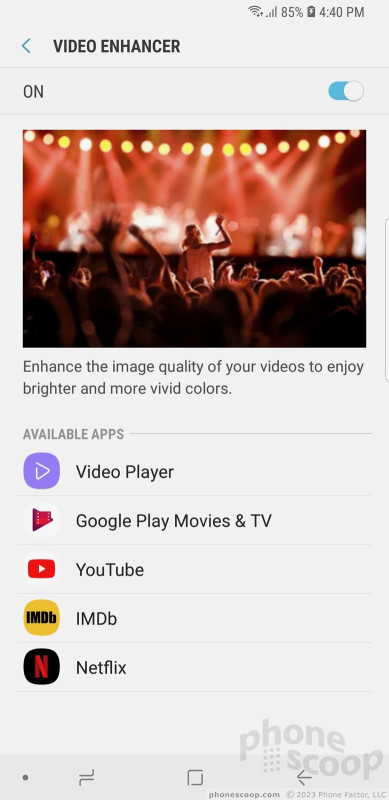




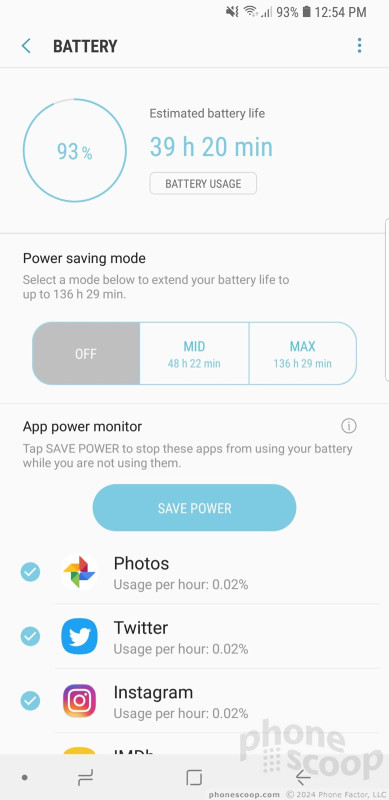






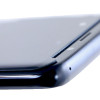 Review: Invisible Shield Glass Curve Elite for Samsung Galaxy S9+
Review: Invisible Shield Glass Curve Elite for Samsung Galaxy S9+
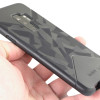 Review: Tech21 Evo Tactical Case for the Samsung Galaxy S9+
Review: Tech21 Evo Tactical Case for the Samsung Galaxy S9+
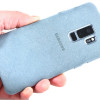 Review: Alcantara Case for Samsung Galaxy S9+
Review: Alcantara Case for Samsung Galaxy S9+
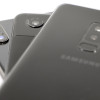 Smartphone Camera Shoot-Out: iPhone X, Pixel 2 XL, Galaxy S9+
Smartphone Camera Shoot-Out: iPhone X, Pixel 2 XL, Galaxy S9+
 Best of MWC 2018
Best of MWC 2018
 Samsung Galaxy S9+
Samsung Galaxy S9+



